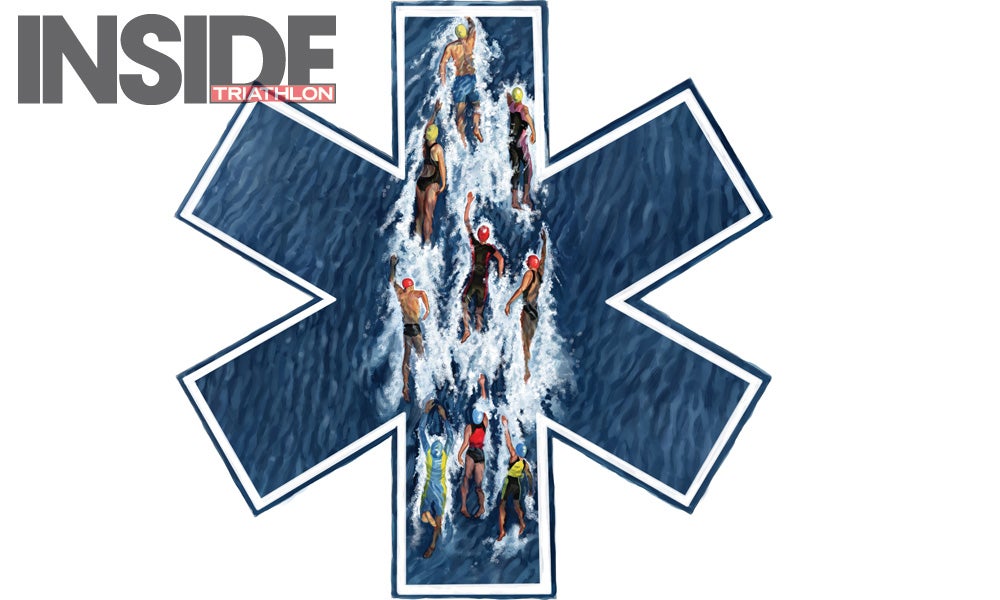Should You Fear The Triathlon Swim?

Illustration by Matt Collins.
Despite inconclusive results, the USA Triathlon Fatality Incidents Study provides some comforting insight into recent deaths in the sport.
This article was originally published in the March/April 2013 issue of Inside Triathlon magazine.
Headlines such as “Participant Dies at Ironman Louisville” and “Triathlete Dies at New York City Triathlon” were alarmingly common in 2011. USA Triathlon reports that there were 12 deaths at its sanctioned events that year, nine of them during the swim leg. This led triathlon’s national governing body to launch an investigation, culminating in the USAT Fatality Incidents Study, released in 2012.
A panel made up of three triathlon-experienced physicians and two race directors reviewed information such as age, gender, length of race and the circumstances of every fatality. They did not have access, however, to the medical history, medical treatment at the event or official autopsy findings of the athletes who died, thus limiting the conclusions that could be drawn. Nonetheless, the five experts arrived at several important observations:
Incidents aren’t skyrocketing
Since reporting 193,262 annual and one-day members in 2003, USA Triathlon’s participation numbers steadily rose to 483,602 in 2011. While the fatality rate has fluctuated year to year, the absolute number of fatalities has increased in tandem with the increased participation rate.
Similar risk to the marathon
Between 2003 and 2011, there were 43 race-related fatalities, making one per 76,000 participants the approximate overall fatality rate for competing triathletes. This frequency is similar to the sport of marathon running. One study on the London Marathon cited a rate of one fatality for every 67,414 runners over a 20-year period, and a separate study found one fatality for every 75,000 runners since 1976 based on data from the Twin Cities and Marine Corps Marathons.
RELATED – Conviction: Deaths In Triathlon
No swim course, age or experience level pattern
Of the 38 non-traumatic deaths, 30 occurred during the swim. The panel couldn’t find any pattern in swim venues, swim distance or type of swim start. The victims also ranged greatly in age and experience level.
See a cardiologist
Sudden cardiac death (SCD) was the cause of nearly all the non-traumatic swim- and run-related fatalities according to available data, at a rate of one per 84,000 participants. According to a recent scientific report published in the New England Journal of Medicine, most (but not all) incidents of SCD are attributed to an underlying, often unrecognized, abnormal heart condition.
No mystery cause
While causes like swimming ability, anxiety, stroke and swimming-induced pulmonary edema (SIPE) have all been popular theories explaining deaths during the swim, the medical review panel found no clear evidence to support them. SIPE—a syndrome that affects swimmers and divers with progressive shortness of breath and low levels of oxygen in the blood, both of which resolve completely when the athlete stops swimming and is taken out of the water—is difficult to diagnose clinically or at autopsy, so it can’t be completely ruled out.
Prevention
The USAT study’s medical review panel recommends visiting your doctor for an exam with an emphasis on heart health before participating. Watch for warning signs during training, such as chest pain or discomfort, shortness of breath, light-headedness, blacking out or an unusually high heart rate, then consult your doctor. If you experience any of those warning signs during the race, stop immediately and seek medical attention. Make sure you practice and prepare for open-water swimming, and be especially attuned to your body’s warning signs during the swim portion. Before the event, learn CPR and be prepared to use those skills during the race if you see a fellow athlete having a medical problem.